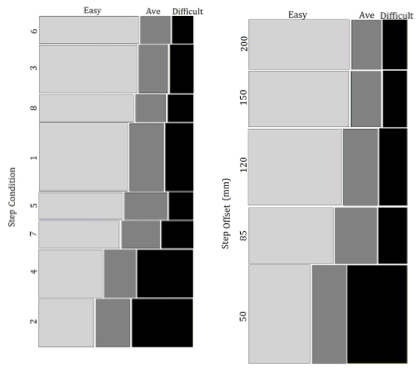Findings
Driver IE System Configuration Preferences
Objective: Quantify the effects of step configuration and subject covariates on drivers’ subjective perceptions of ingress/egress difficulty
Method: Drivers were asked to assess the ease or difficulty of ingress and egress on a seven-point scale immediately after getting in or out. The driver rated the difficulty from very easy (1) to very difficult (7), with four being “average”, defined as the level of difficulty the driver experienced when getting into or out of the truck he or she was most familiar with. The ease/difficulty ratings were recorded for the ingress and the egress in each trial for a total of two ratings per trial.
The poorly rated conditions were compared to the highly rated configurations to discover which qualities were responsible for the rating disparity. The lateral distance of the top stop, lateral distance of the bottom step, and the offset between the two steps were examined. The effects of handle configuration and subject anthropometry were also examined.
Results: Step conditions two and four were consistently rated as the most difficult to complete while conditions eight, six, and three were rated as easiest (see figure). The lateral step offset distance between the two steps was found to be the most influential variable affecting drivers' perception of ease or difficulty. The larger the step offset, the more likely the driver was to rate the condition as easier than average to perform (see figure). Most of the effect was due to the significant difference between the lowest and most poorly rated offset (50 mm) and all of the others. The effect was most pronounced in driver ingress and to a lesser extent in egress.
Key Findings:
• Drivers’ ratings of ease of ingress and egress differ significantly across step configurations.
• Drivers prefer step configurations with larger lateral offset between the step edges.
• Short-stature drivers rate configurations as more difficult than taller drivers.
• Obese drivers are less likely than non-obese drivers to rate a configuration as “easy”.

©2017 University of Michigan